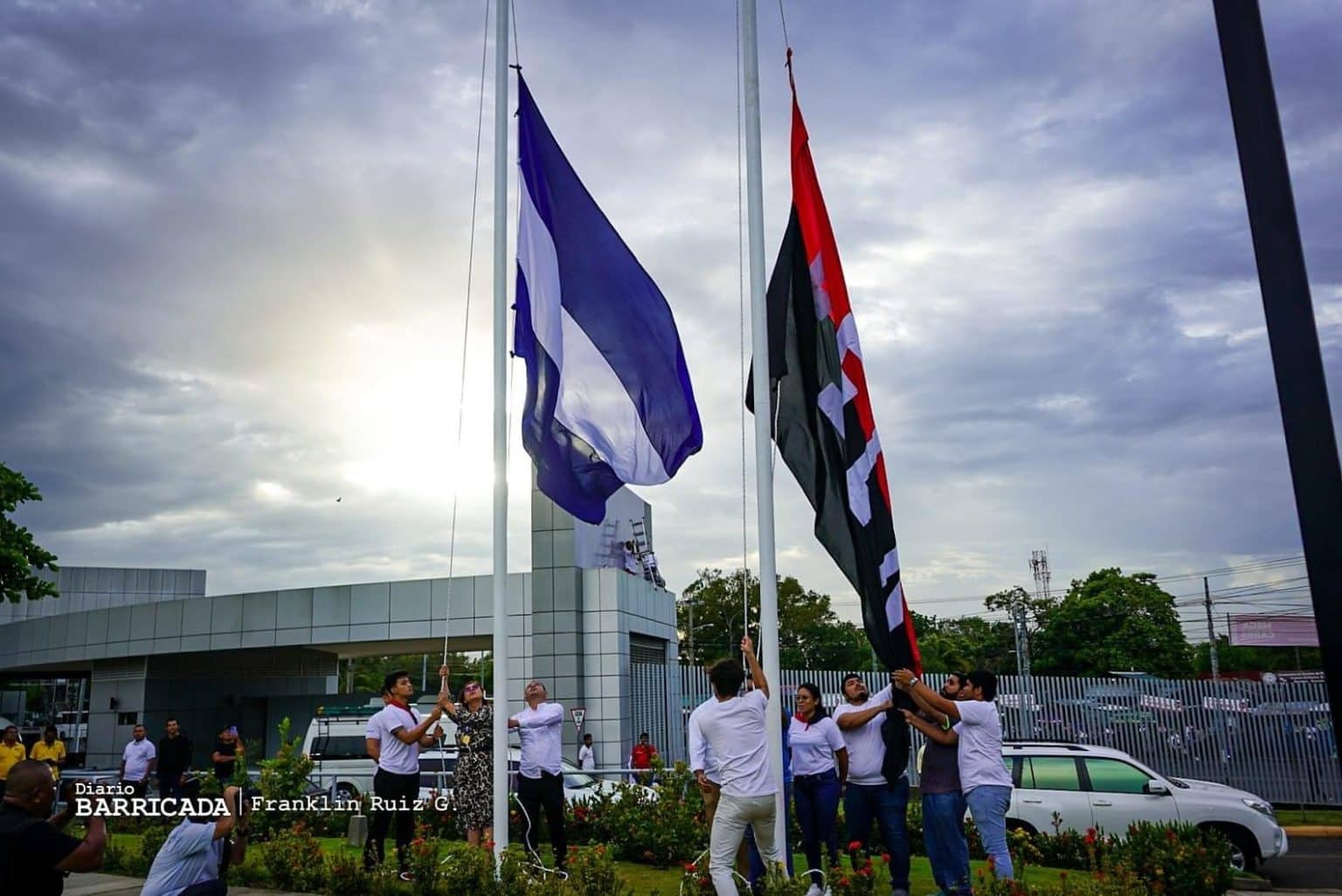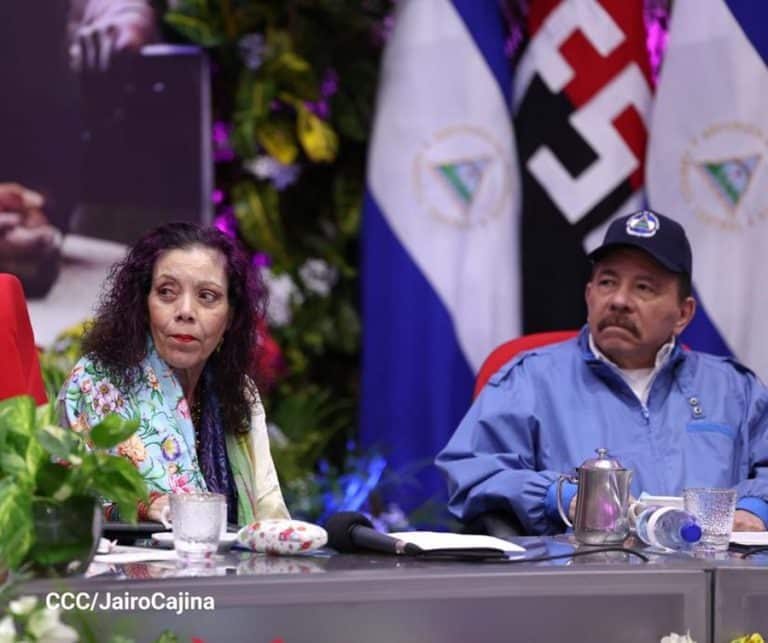27 de diciembre 2023

European Concern over Lack of Academic Freedom in Nicaragua

PUBLICIDAD 1M
PUBLICIDAD 4D
PUBLICIDAD 5D
Every time the regime has had an opportunity to light the way to the future, they’ve instead turned the spotlight on a past where they feel comfortable

The rulers of Nicaragua, Rosario Murillo and Daniel Ortega. Photo: The Presidency
When authoritarian regimes dedicate the greater part of their time to preserving the caboose of their past as their sole strategy, it’s because they’ve lost the train of the future. However, since the past is no longer enough to justify themselves in the present, and the future has escaped them like sand through their fingers, they find themselves trapped between a past that has become the only possible path, and a future that’s lost in the horizon of the rearview mirror.
The Ortega-Murillo dictatorship finds itself in this situation: their backs to a future they’ve never been capable of sketching – except for the white smoke of their megaprojects – while in front of them stretches a past of old glories, whose second incarnation they hope to lead.
Sixteen years in power has demonstrated it: the future is already water under the bridge; when the waters were rushing by them, they didn’t know how to deal with it. Maybe it was during the first government [after returning to power], between 2007 and 2012, when they proclaimed an inclusive social project, but a politically exclusive one. The promises of ending hunger and constructing streets and homes for all covered up the first restrictions to civil liberties. It was the moment of replaying that old trick of the authoritarian left: equality in exchange for liberty.
But that future gradually lost its color, as the gigantic billboards of the ruling duo proliferated and the present became a showcase for the “new regime’s” authoritarian vocation, following the imposition of the Councils of Citizens’ Power; the massive fraud of the 2008 municipal elections; and the occupation of the Managua roundabouts by hordes of alleged prayer warriors. Everything began to sound like yesterday’s paper in the memory of a people who had seen two authoritarian regimes in under 30 years.
The future was soon devoured by the limitless whims of a first lady who one day decided that in Nicaragua it would be Christmas all year round; and that we should live looking lovely, even though poverty was suffocating the neighborhoods; and that the media should interrupt their programming for a national broadcast whenever her dilapidated husband launched his boring and nonsensical diatribes.
The years that followed only confirmed that the regime was trapped in its own time tunnel. It had the opportunity to finish the work of founding a modern government, but it opted for the archaic path of restoring the sultanic regime of Somoza – a backwards turn that caused the entire political system to pivot around one family. They also had the chance to forge a professional public administration based on merit but preferred to return to the practice of public employees recruited for their loyalty to a fizzy ideology and their fear of the “Compañera’s” temper tantrums.
Set before the dilemma of opting for an economy governed by the marketplace, or a government that redistributed wealth to even the inequalities, the dictatorship found a shorter regressive route: the good ol’ boy capitalism of the twentieth century, meaning the reconcentration of wealth in the hands of the ruling family and their close collaborators, plus the well-behaved capitalists. It was the restoration of the Somocista maxim: “plata para los amigos, palo para los indecisos y plomo para los enemigos” (money for our friends, beatings for the undecided, and lead for our enemies).
In this reactionary wave, things haven’t gone any better for the regime’s party. If there’s one organization with their backs to the future and self-absorbed in the past, that would be the FSLN. This is at least partly due to the tiresome liturgy that, by force of repetition year after year, has continued losing meaning and transcendence. What are the gatherings of the July 19th anniversary, except the same performance every year, in which the high lord rambles on about anything at all with no direction or content? What are the commemorations of the Repliegue [marking a tactic of the war against Somoza]; the birth dates of Sandino and Carlos Fonseca, and other such dates, except excuses to drape the future with the past?
Irrefutable proof of this stagnation reeking of mothballs is the absence of “aggiomamento,” the updating of the FSLN discourse in the face of the huge challenges that humanity is experiencing, but also of the deep crisis that Nicaragua is passing through. The last time that the FSLN proclaimed their plan for the future is lost in the shadows of a remote past. One small sample: What does the former “vanguard of the people” think about the massive migration of Nicaraguans towards anywhere on the world’s four corners? Instead of that, they prefer to continue sitting on the sacks of dollars that the family remittances bring them, while reveling in their past “of corpses and flowers.”
Within the FSLN, the tendency to strengthen institutions – hence of modernization – that was being tried after 1990 hit the brakes after Ortega’s return to power in 2007. The party was also absorbed by the centrifugal force of the dynastic model. The internal structures were erased by a stroke of the pen. The Party Congresses became noonday gatherings to glorify the eternal candidate; the national directorate has been taken over by the ruling couple’s children; the Sandinista Assembly closed and demolished; and the territorial network, that in the beginning became a framework to steal the elections, years later turned into the repression’s paramilitary machinery, supported by the local feudal lords with permission to loot the public contracts in the municipalities.
Every time the Ortega regime has had an opportunity to light the way to the future, they’ve turned the spotlight around towards a past where they feel more comfortable. It’s no coincidence. The future implies uncertainty, and uncertainty torments dictatorships, because what might come often escapes their control. A false step can unleash a social explosion, a beauty pageant can fill the streets with the same volatile matter that derailed their plan for domination in 2018, spontaneity can transform into courage; a spark of joy that can once more inflame the buried rebellion that nests in every Nicaraguan who refuses to let themselves be subjugated.
The dictatorship has no future, like any organization anchored in resentment, a murky sentiment that’s a vestige of a past full of hate and animus. In addition, if a political regime positions its past as the only measure of what could come, it has nothing to offer other than oppression, torture, and exile. And yet, it’s condemned to face unforeseen circumstances, those leprechauns that turn the handle of the future. It’s useless to try and escape the laws of time; no matter how much the dictatorship lives with their faces turned to the past, they can’t keep the future from trapping them in the end. There are no possible spells to ward off the ambushes of what’s going to happen.
This article was originally published in Spanish in Confidencial and translated by Havana Times.
PUBLICIDAD 3M
Politólogo y sociólogo nicaragüense, viviendo en España. Es municipalista e investigador en temas relacionados con participación ciudadana y sociedad civil.
PUBLICIDAD 3D